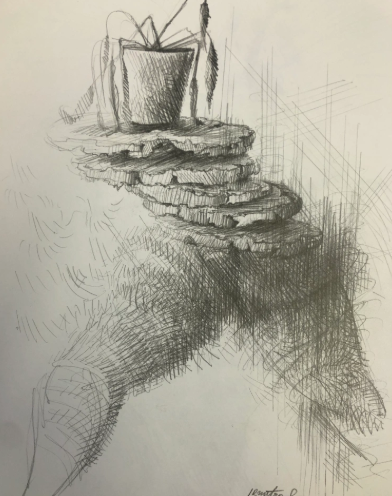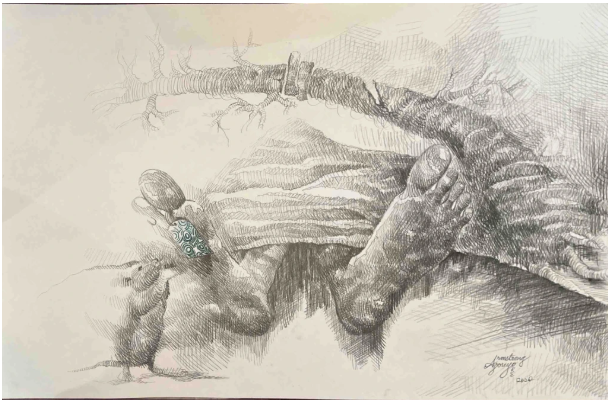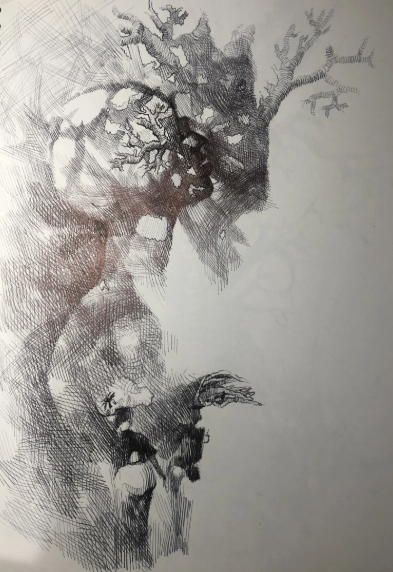“Roots of Reflection: Armstrong Agoreyo’s Surreal Exploration of Life and Nature”
Written by Ade Olusola Kunmi
Armstrong Agoreyo’s recent unveilings marks a compelling departure from his previous works, embracing the enigmatic and dreamlike world of surrealism. His four new paintings—”Over Nature’s Dead Body,” “Obinrin,” “Grasping for Death,” and “Greed is Blind”—present a thought-provoking exploration of life, death, and our intrinsic connection to nature. Each piece serves as a visual and philosophical journey, inviting viewers to ponder the often overlooked aspects of existence.
“Over Nature’s Dead Body”
In “Over Nature’s Dead Body,” Agoreyo utilizes charcoal to create a stark, monochromatic scene that is both haunting and contemplative. The painting features a corpse laid upon the earth, with tree roots intertwining through the body, symbolizing the cycle of life and death. The presence of a rat gnawing at the feet adds a grim reminder of nature’s relentless cycle. This piece poignantly illustrates the inevitability of death and our return to the earth, suggesting that even in death, we contribute to the natural world. The image compels viewers to reflect on mortality and the enduring impact of our physical forms on the environment.
“Obinrin”
“Obinrin,” which translates to “woman” in Yoruba, is a celebration of the feminine connection to nature and their vital role in society. The central figure, a woman whose body seamlessly integrates with tree branches, symbolizes the deep-rooted connection women have with the earth. Below her, two women engage in daily activities—one carrying a baby and the other firewood—emphasizing the essential roles women play in nurturing and sustaining life. The tree branches extending from the woman’s head signify wisdom and growth, reinforcing the idea that women are fundamental to the continuity and prosperity of both nature and society.
“Grasping for Death”
In “Grasping for Death,” Agoreyo ventures into the realm of the surreal with an alien-like form adorned with growing trees. This piece, also rendered in charcoal, diverges significantly from his previous thematic expressions, showcasing his versatility and willingness to explore new artistic territories. The otherworldly figure and the organic elements intertwined with it suggest a symbiosis between life and death, nature and the unknown. The painting’s abstract nature encourages viewers to interpret its meaning, potentially reflecting on the alienation from or integration with the natural world in the face of mortality.
“Greed is Blind”
“Greed is Blind” presents a more overt critique of human nature through surrealistic imagery. The painting depicts disembodied human legs walking with a torso made of sliced wood, topped with a bucket of dead plants. This striking composition highlights the destructive consequences of greed and the disconnection from nature it fosters. The wooden torso and dead plants symbolize the depletion and fragmentation caused by avarice, suggesting that greed blinds individuals to the vitality of life and the health of the environment. This piece challenges viewers to consider their own actions and their impact on the natural world.
Overall Impression
Agoreyo’s latest works are a testament to his evolving artistic vision and his ability to provoke deep thought through surrealism. The recurring motifs of trees and nature reflect a profound contemplation of our relationship with the environment. These paintings are unsettling yet captivating, urging viewers to confront the realities of life, death, and our symbiotic existence with nature. By delving into themes often left unexamined, Agoreyo continues to push the boundaries of contemporary art, offering a unique perspective that is both introspective and universally resonant.



